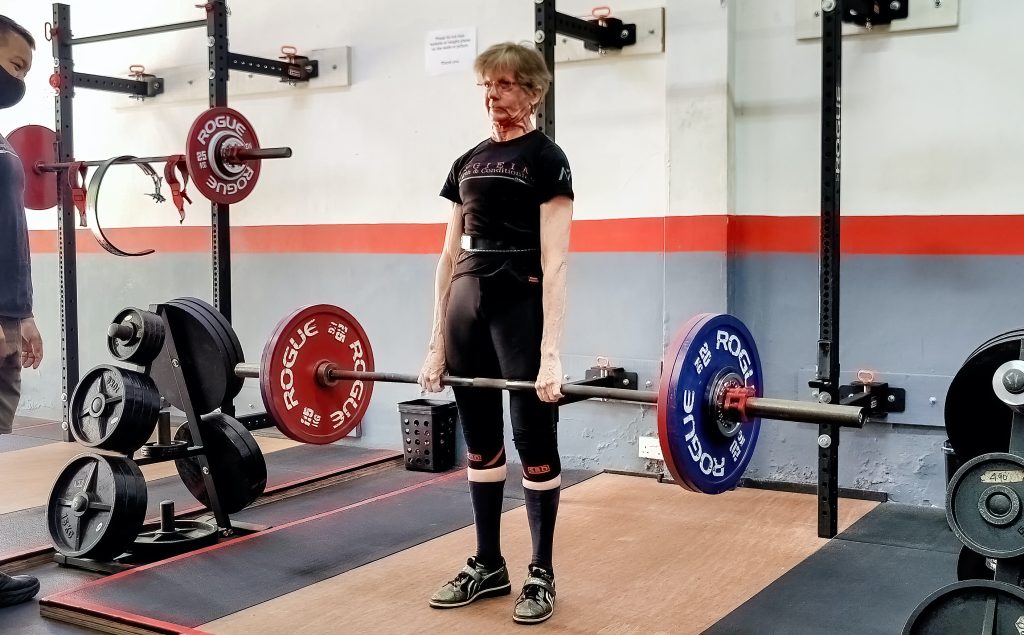
Sometimes, it feels like those of us who’ve discovered barbell strength training belong to a secret club. We love what we do. We know the benefits of strength training and how awesome it feels to be strong.
But when we try to spread the love to family and friends so that they too can reap the benefits of being strong, inevitably, somebody will say, “Lifting barbells? Isn’t that dangerous? What if you hurt your back/knees/shoulders? You’ll regret it when you get older!”
Unfortunately, it’s a pretty common response. Others include “Oh, I’m too old to be doing something so risky”, “No way, I have (insert health condition)” or “My friend lifted weights and hurt his back! Are you sure you want to keep doing this?”
For the layperson, barbell training is perceived as a dangerous and injury prone activity. But is it really? Let’s discuss.
What is “risk” anyway?
In normal usage, the word itself carries a negative connotation. The dictionary defines it as “a situation involving exposure to danger”. Put differently, it’s the possibility of something bad happening.
Risk, however, doesn’t have to be bad. The standard definition of risk across different applications from business to science is “the effect of uncertainty on objectives”. In these contexts, risk is actually neutral. It’s something that exists whenever you take an action towards your goals. Instead of fearing and avoiding risk, it’s more useful to identify and understand it, in order to manage and minimise its potential negative effects.
Risk is actually unavoidable
If you haven’t already figured it out, every single thing you do has risk. When you invest, you risk losing your money. When you ask someone out or your boss for a raise or promotion, you risk getting rejected. Similarly, when you engage in physical activity, there’s the risk of injury.
Does this mean avoiding doing anything? Do you then avoid all physical activity and be sedentary? No, because being sedentary is also an action that carries its own set of risks. (More on this later.)
Instead, whenever we’re faced with a choice, we perform a “cost-benefit analysis”.
This is a systematic approach, often used in business, for comparing the costs of a decision with its benefits before making any decision. While we won’t quantify the alternatives like a business would, we borrow the basic concept: be aware of all options, weigh the risk for and against each one, what benefits each decision brings, and then decide what to do.
Actually, you’re probably already doing this, just unconsciously. Say you want to get to a destination. You could take a car or walk. Clearly, taking a car is risky. In fact, people get hurt or die in car accidents relatively frequently, but almost nobody thinks about it. They just get into the car and fully expect to reach their destination unscathed. The benefit of reaching their destination quicker, with much less effort than walking, is worth the relatively small risk of getting into an accident.
Let’s do a similar analysis, to understand the risks of being physically active and being sedentary.
The risk of being sedentary is greater than you think
What’s the benefit of being sedentary? Well, you definitely won’t get injured from being physically active.
Inactivity, however, carries its own risks. Humans are just not made to be sedentary.
Over extended periods of inactivity, we lose muscle mass and bone density.
If you’re an older adult, these will compound other issues associated with aging, leading to general frailty, loss of function, loss of mobility and physical independence, and increased likelihood of falling (which may lead to a problematic injury). Think being sedentary means you’ll be injury free and therefore have no aches and pains? Ask any sedentary person over the age of 40 if they have any aches and pains and chances are the answer will be yes.
On the other hand, being physically active has clear benefits. Depending on the type of physical activity that you engage in, these benefits include stronger muscles and bones, increased energy levels, reduced risk of illnesses like diabetes and heart disease, improved brain function, and better overall health and wellbeing.
Weighing both sides, it’s clear that the benefits are limited (no injury from being physically active), but the costs are considerable (poor health). So if you give it some thought, being sedentary is actually pretty risky.
The risk of being physically active
What about engaging in physical activity? Specifically, something “dangerous” like barbell strength training?
Well, if you ask orthopaedic doctors or physiotherapists whether barbell strength training is dangerous, high chance that they’ll say yes. If one is going to see them, it’s almost certain that they’re injured. No one’s going to see them if all’s fine and dandy. So if every lifter that these doctors or physiotherapists interact with is injured, it’s easy to have a negative view of barbell training.
What if we look at some actual data? When you compare injuries across sports, what’s surprising is that barbell strength sports in general has some of the lowest injury rates. In fact, the most common fitness choices like running result in more injuries per hour of participation than lifting.

To us, it’s baffling why people are fine with these supposedly “safe” exercises like running, but freak out about barbells. Most parents won’t let their kids lift weights, but are okay with them playing football or basketball, which has a significantly higher risk of injury. Perhaps it’s a matter of perception. The myth that “lifting will stun a kid’s growth” certainly does barbell training no favours.
What we experience in our gym is actually quite different. The Starting Strength programme is methodical, logical and well thought out. The goal is to build strength, with all its attendant health benefits.
Again, when we compare the costs and benefits, we see that the risk of barbell training is definitely lower than it is generally perceived to be.
Barbell strength training as “medicine” for the ageing adult
But what about for older folks? Surely lifting barbells is too much for this demographic – what if they break their frail bones? Perhaps they should do something more gentle, like walking?
For older people, however, just simply exercising isn’t sufficient. If they want to combat the degenerative effects of ageing, they need to be doing specific exercises, programmed in a specific way. In short, they need to train to get stronger.
What then is the best option? For any physical activity to function as “medicine” for the ageing adult, there are 5 criteria:
- safety – in other words, low risk of injury
- a wide therapeutic window – its availability in both low and high intensities
- comprehensiveness – it should be a complete and integrated regimen
- specificity – it should target the effects of aging, i.e., it fights sarcopenia/dynapenia and osteopenia/osteoporosis. Restores strength, mobility, balance and function
- simplicity and efficiency – to make it accessible and progressive for long-term sustainability
Looking at these criteria, it’s clear that just doing aerobics or walking three times a week won’t be enough. Yes, any exercise is better than none but if you want to specifically combat the effects of ageing, the usual cardiovascular exercise isn’t going to cut it.
The most effective and rational prescription would be a methodical, scalable and progressive training program that focuses on strength.
Barbell strength training is one such candidate. The basic barbell lifts mimic normal human movements, just loaded with weights to build strength/muscle and bone. We pay attention to good technique, and adjust accordingly to each individual’s limitations. The weights start at something that’s manageable for the individual and gradually increased in small increments, allowing for safe and steady progress.
In short, barbells are an excellent, and low-risk, choice for older folks.
Know how to reduce risk while maximising benefit
Hope that you’re now able to see that it’s far more risky not to exercise, that barbell training injury rates are actually pretty low, and that barbell strength training is an ideal exercise for older folks.
Still, training with barbells is not risk-free (nothing is). People will occasionally get injured, but what we can do is consciously minimise the risk of injury. We do this by performing the lifts safely and efficiently, and by following a programme that’s well thought out and appropriate for each particular lifter.
While you might occasionally experience an injury such as muscle strains or back tweaks, these can be recovered from relatively quickly under good supervision.
So yes, there will always be risk. But risks, if understood and analysed, can be managed and minimised. Barbell training may seem scary at first, but properly executed, the upside is the huge benefit of staying strong and healthy as you age.

